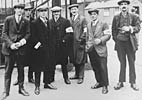In 1925 when employers attempted to impose yet another round of wage cuts and a lengthening of hours, they were faced with more formidable opposition from a re-grouped Triple Alliance of mine, railway and transport unions and the unofficial National Minority Movement formed in 1924.
Strike action was threatened and on the day the strike would have started, Friday 31 July 1925, the Government announced that it would grant a subsidy to the coal industry for nine months while a Royal Commission conducted an inquiry. This victory, accomplished without strike action, was hailed in banner headlines in the 'Daily Herald' as 'Red Friday', although as events were to show, Red Friday, significant as it was, was more of a truce than a victory.
The report of the Royal Commission (the Samuel Commission) was delivered in 1926. It rejected a continuation of the Government subsidy and approved the wage reductions that the owners had tried to enforce the previous year. The miners, under the leadership of A.J.Cook, swiftly announced their intention to fight under the slogan 'not a penny off the pay, not a second on the day'.
The owners posted the lock-out notices and, after fruitless attempts at negotiation between the government, the coal owners and the TUC, a special conference of trade union executives was convened on May 1st to approve plans for a 'national' strike in defence of the miners.
Professor Mary Davis, Centre for Trade Union Studies, London Metropolitan University
Click here to view documents and pictures








